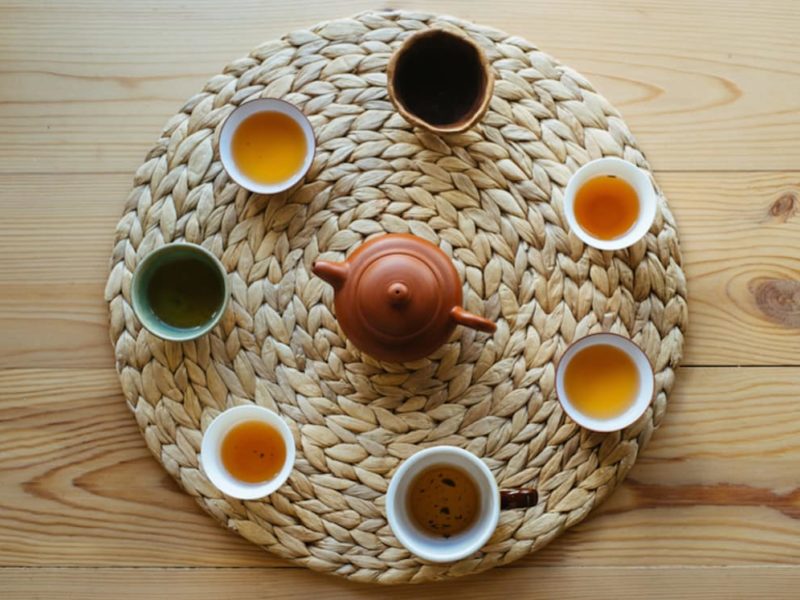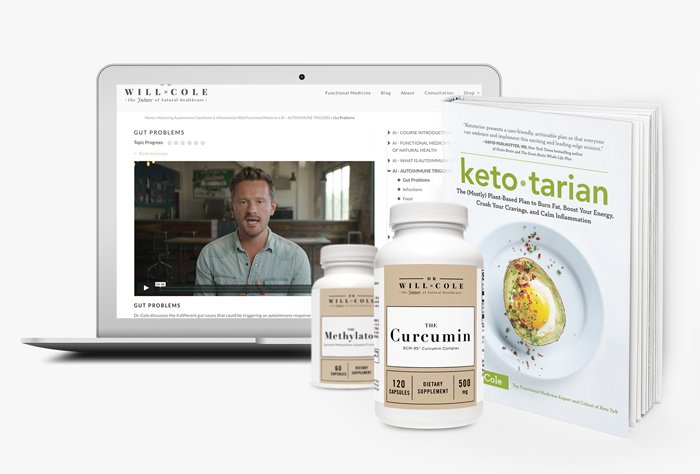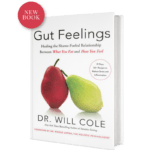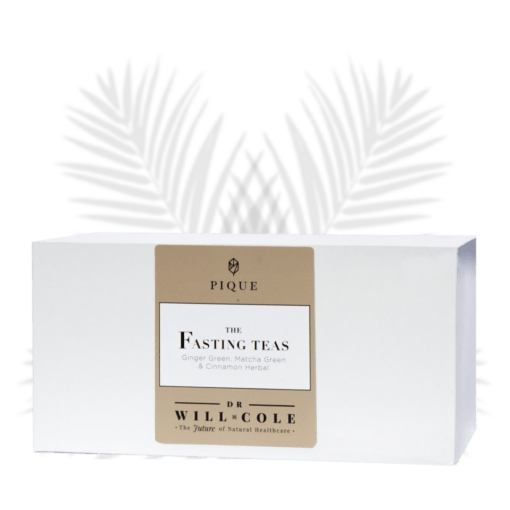Your Go-To Guide To The Wonderful World Of Tea

My staff makes fun of me for being a “beverage guy,” and it’s true. When I go out for lunch or dinner, I usually order more than one beverage. I love juices, smoothies, tisanes, and tea…but especially tea. If I could only drink one thing for the rest of my life, it would be tea. When I am with patients at my functional medicine center, I am almost always sipping on some sort of tea, and I consider myself somewhat of an amateur expert because in my world, tea is not just delicious. It is therapeutic. If you think you aren’t really a “tea person,” I challenge you to let me try changing your mind. The world of tea offers something for everyone, depending on your taste, mood, and health goals. Let’s take a closer look at the wonderful world of tea.
All true tea comes from the tea plant, Camellia sinensis. Yes, all tea: Black tea, green tea, white tea, and oolong tea all come from the same plant. Anything else is technically a tisane, or what people call “herbal tea” (which is not really tea at all). How are so many different teas, which have completely different tastes, made from the same plant? It’s all in how the plant is grown, harvested, and prepared. And while all types of tea contain antioxidant, (1) antibacterial, anti-inflammatory, and antiviral benefits (due to the polyphenol called catechin and the antioxidant content) each type of tea also contains unique benefits. Knowing these can help you choose the right tea for you, not just based on taste, but on what it can do for your health. Consider this your tea prescription guide.
Keep in mind that although tea tends to have less caffeine than most coffee, all tea has at least some caffeine. If you are a slow metabolizer of caffeine (which you can find out with a DNA test), caffeine may be more difficult for you. Your caffeine gene CYP1A2 has two variants, slow and fast. If you have one or two slow variants that will mean you are a slow metabolizer.
However, even for slow metabolizers the benefits of tea usually outweigh the caffeine amount. Just limit your intake and if it makes you feel jittery, cut back or go decaf (which still has some antioxidants).
Article continues below
Make Your Life a Cleanse
SUBSCRIBER-ONLY GUIDES FOR GUT HEALTH, VIBRANT ENERGY, HEALTHY FOOD & CLEAN ALCOHOL
Get FREE access to these + giveaways, recipes, & discount codes in personal emails from Dr. Will Cole.
First, some general tea notes:
- If you want to get the most epigallocatechin gallate (EGCG) action out of your tea, drink it hot rather than iced to get the maximum effect of this antioxidant.
- Adding milk (including plant milks like almond or coconut milk) may make the antioxidants less bioavailable.
- Avoid tea made in China. Heavy metals such as lead can be found in many plant products because it is absorbed from the soil. Tea is known to absorb lead at a higher rate than some other plants. White tea, because it is picked sooner, probably has less heavy metals than other types. However, studies (2) have found that Chinese industrial pollution is a primary source of lead in tea leaves. This is less of a problem in tea made in Japan, and even less of a problem if the tea is organic.
Types of Tea
1. White tea
White tea is made from brand-new growth buds and young leaves of the tea plant. In order to inactivate oxidation, the leaves and buds are steamed and then dried. Since it is minimally processed, its antioxidant content is slightly higher (3) than that of other varieties of tea. It is characterized by its light color and mild flavor, so if you think you don’t like the taste of tea, you might like this tea. It is an extremely easy tea to drink and has the lowest caffeine content of all tea types, making it a great choice if caffeine isn’t your thing but you still want a little pick-me-up.
2. Green tea
The Beyonce of tea, green tea is one of the most popular teas and lands taste-wise between white and black. Harvested later than white tea, green tea does not go through the same oxidation process that oolong and black tea go through. Like white tea, this allows for some of the highest levels of catechins, specifically the uber-beneficial compound epigallocatechin gallate (EGCG). It’s been shown in a number of exciting studies (4) to have many health-boosting qualities, such as:
- Boosting metabolism
- Improving skin quality
- Slowing down aging
- Decreasing cancer growth
- Improving brain function
- Protecting from brain diseases
- Reducing heart disease risk
- Reversing diabetes
- Decreasing inflammation by boosting pro-antioxidant Nrf2 pathways and decreasing pro-inflammatory Nfkb activity.
Another fun thing about green tea is its many forms, each with its own taste and nutrient profile – like beer or wine, but without the hangover! Cheers! Here are the green tea superstars:
Matcha:
Matcha is a green powder made from the whole green tea leaf, so when you drink it, you drink the actual leaf. Unlike many other green teas, plants used for matcha are first covered and grown in the shade for weeks before they are harvested, resulting in boosted chlorophyll levels, which gives it the bright green color it is known for.
The green tea leaves are then laid out to dry, then ground into the fine green powder you see in the store or cafe. Unlike regular green tea, which is steeped in bags or with a steeper so you can drink the water but not the tea leaves, with matcha you are drinking the whole leaf, whisked into hot water, latte, or a blender.
The really cool thing about matcha is that, although it is more expensive than regular old tea bags, it has significantly higher levels of EGCG than other green teas – compared to the highest levels of EGCG in regular green tea reported in the medical literature, one study (5) found that matcha had up to three times more EGCG! Similarly, another study (6) compared the major green tea and matcha brands and found that matcha powders had higher concentrations of EGCG (50 to 55 mg of EGCG per gram of tea) compared to brewed teas (20 to 40 mg of EGCG per gram of tea).
Most of the research done on the benefits of green tea have found the optimal amount to be 100 to 200 mg of EGCG, which comes to about 2 to 5 cups of matcha per day, depending on the strength.
While matcha has more antioxidants, it costs at least $1 per teaspoon, which is the serving size. Compare that to around 10 to 25 cents for the average green tea bag. The cost to get your 200 mg of EGCG will be around $2 with matcha. Since you’ll need to drink more green tea to get the same amount of EGCG it will only be slightly less at around $1.60. So while you may be saving a little bit of money you’ll have to drink a lot more tea. And if you’re simply looking for EGCG, the highest amount can actually be found in gyukuro green tea, which isn’t matcha or regular green tea at all.
Sencha:
Sencha is brewed by infusing the whole tea leaves in water to produce a very mild and pleasant taste. Harvested early on in the season, sencha is made from some of the most flavorful top leaves. It’s no wonder that this is the most popular tea in Japan.
Gyukuro:
Similar to sencha in taste but similar to matcha in that the leaves are shade-grown (resulting in a more intense flavor) and the EGCG content is exceptionally high.
Bancha:
More bitter in taste, bancha has the lowest caffeine content of all green tea varieties. It is harvested from the same tree as sencha but later in the season, making it one of the cheapest, most commonly found green teas out there.
3. Black tea
When the tea leaf is harvested to make black tea, enzymes are activated, resulting in oxidation, leading to a withering of the leaves. Depending on the specific temperature and humidity controls, the leaves brown, and the desired taste and aroma is achieved. Since black teas are oxidized, the catechins originally present are converted to theaflavins. While the high catechin content in green tea is a major health benefit, studies (7) have shown that theaflavins are just as powerful antioxidants, making black tea a perfect choice if you are needing a boost of caffeine but still want the antioxidant power.
Many types of black teas are blends of different varieties of black teas from different regions. Black tea has the highest caffeine content of all tea types. Black teas don’t tend the differ too much in health benefits; choosing the right one for you is really a matter of taste. Some of the most common black teas include:
Earl Grey:
Black tea with bergamot oil. Bergamot is most common found in Italy but also native to Southeast Asia, Argentina, Morocco, Brazil, and Turkey, produces an orange/lemon-like citrus fruit, also known as the bergamot orange, that has powerful healing qualities.
Bergamot oil has mood-boosting benefits, which can help to alleviate depression and anxiety. It is also a powerful antibacterial and antifungal due to its ability to suppress the growth and spread of bacteria and fungi.
English Breakfast:
A blend of Assam, Kenyan, and Ceylon varieties of black tea. To everyone in the United Kingdom, this is the only tea that exists. All else is sacrilegious.
Irish Breakfast:
Another blend of different varieties of black teas.
4. Oolong tea
One of the biggest benefits of oolong tea comes from its weight-management properties. Similar to green tea, studies have shown (8) that regularly drinking oolong tea can help prevent obesity by reducing weight through boosting fat metabolism or lipolysis. It can even suppress the creation of new fat cells! (9)
The bottom line? All tea is super healthy, so choose based on your personal goals and flavor preferences.
How Much Tea Should I Drink?
We’ve all read about the benefits of tea, that’s also why nutritionists from all around the world, including the Harvard School of Public Health recommends drinking tea at least three times a day (10) to unlock it’s powerful benefits.
Here are 3 reasons why you should pick up the 3 cups a day habit. Not just because it’s recommended, but really to understand what goes on in your body when you nourish it with tea goodness.
1. Supports immunity
Brew up a defense force within your body. Three cups of tea can help support your immunity. The Harvard School of Public Health and NIH have linked drinking tea to supporting heart health, supporting healthy blood pressure, and supporting cellular health. Some studies have actually shown its benefits being shown in a little less than a week with just one quart of tea.
2. Constant flow of antioxidants
When you drink tea throughout the day, you’re keeping antioxidants flowing through your body. These antioxidants are polyphenols and catechins called Epigallocatechin Gallate (EGCG). (11) Catechins are natural antioxidants that help support healthy cells by fighting free radicals. Talk about having a natural defense mechanism running throughout your body!
These polyphenol antioxidants are best absorbed on an empty stomach, similar to other compounds that are affected by food. I would recommend starting your morning with a cup and slowly sipping throughout the day. Once you keep this habit going, you will soon feel a difference in your energy level and mental clarity.
If this is the moment where you’re wondering how to find the time to brew up to 3 cups of tea a day, Pique Tea may just be the solution to your problem! It’s the world’s first instant cold brew tea that dissolves in cold and hot water, thus making it super convenient to drink on-the-go while unlocking many of its benefits.
Through a proprietary Cold CrystallizationTM process, Pique is able to extract the active ingredients in tea and super plants at maximum capacity – and preserve them in an easily dissolvable form. Through this method, Pique is able to deliver 6 times the antioxidants of a regular tea bag and up to 20 times that of bottled tea (third party verified). Its potent, powerful, and also a great way to hack hydration in a healthy way.
Note: Pique Tea’s Mint Green, has the lowest caffeine content and tastes just as good both cold and hot if you want a little less caffeine.
3. Source of l-theanine
Tea contains an amino acid called l-theanine. It supports alpha activity in the brain which in turn supports alertness, memory, and creativity. It also supports a calm, non-anxious mood. The combination of caffeine and l-theanine in tea work synergistically together to support healthy brain function.
The l-theanine molecules neutralize the jittery and edgy effects of caffeine, without affecting your focus and clarity. You’re essentially getting the best of both worlds in every serving! Drinking tea also produces a similar feeling to a deep meditative state. It’s no wonder why Buddhist monks were so attached to tea not only for health purposes, but also during long hours of meditation to stimulate and sharpen their senses.
Lastly, drinking 3 cups of tea a day will not break the bank. Teas can much more affordable than coffee, and you can get a diverse and healthy selection for a reasonable price to supply your 3 cups a day routine. Also, a cup of tea typically contains much less caffeine to a cup of coffee – about 10 mg to 50 mg – compared to a cup of ten times as much.
Pique Tea is the first and only tea company to show the measurable amount of caffeine and l-theanine levels check them out here.
The Best Caffeine-Free Tea Varieties
You’ll almost always find me with a cup of tea in my hand. Green tea is my usual tea of choice due to its various health benefits and caffeine content, which is much-needed during a day seeing patients at my functional medicine clinic. While green tea is a great all-around choice, there is a whole world of tea to explore.
I went into detail earlier about the difference between white, green, black, and oolong teas. These are just the tip of the iceberg when it comes to the different types of teas available.
One type of tea is herbal teas. These are made from a combination of plants, fruits, herbs and spices and are caffeine-free. But what they lack in the caffeine department they make up for with their powerful health benefits. Whatever health problem you are dealing with, chances are there is an herbal tea out there to help your symptoms.
The ones listed here are just a small sampling of all the herbal teas available. I could fill a whole book if I included every type. But let this be your go-to guide for your most common health problems.
So, grab your favorite mug and steep away your health woes – one cup at a time.
Stress + Anxiety
Chamomile: Chamomile has been shown (12) to help relieve anxiety by promoting relaxation – a perfect tea to sip before bedtime.
Passionflower: This tea can increase GABA, which promotes relaxation and, in turn, can be just as effective (13) as oxazepam for reducing anxiety, according to some studies.
Kava: This herb is a very common natural anti-anxiety remedy. (14)
Beauty
Rooibos: This tea originates from South Africa and is packed with antioxidants. These help to fight free radical damage that can contribute to skin aging.
Rosehip: This tea also helps fight free radical damage and boosts cell rejuvenation to keep skin looking youthful.
Balanced blood sugar
Lemon Balm: This helps to regulate insulin production by replenishing the nervous system.
Hibiscus: According to studies, (15) hibiscus helps inhibit glucose absorption which keeps blood sugar balanced.
Bilberry: Bilberry contains flavonoids called anthocyanosides that have shown positive results (16) in maintaining blood sugar levels.
Detoxification
Dandelion: While a nuisance to most gardeners this weed helps to flush out toxins through its intensive liver-supporting abilities.
Burdock root: This tea can help remove toxins, specifically heavy metals, through increased fluid excretion due to it’s natural diuretic properties. It can also increase detoxification by giving your lymphatic system a boost.
Red clover: Red clover helps to rid toxins from the lymphatic system, spleen, and liver.
Fatigue
Rooibos: Also known as African red bush tea, rooibos can bring balance (17) to cortisol – your body’s main stress hormone.
Licorice: Keeps your cortisol levels balanced. (18)
Gut health
Licorice: Deglycyrrhizinated (DGL) licorice helps bring healing to damaged gut lining.
Peppermint: This herb can reduce inflammation and has been shown (19) to help those struggling with IBS.
Slippery elm: This type of elm tree is a known demulcent able to reduce inflammation in the gut which helps to ease symptoms of leaky gut syndrome, IBS, and other digestive problems.
Marshmallow root: No, not the sticky-sweet ingredient to your s’more. This root repairs damaged gut lining and can help heal leaky gut syndrome. It is able to relieve symptoms of constipation, diarrhea, and heartburn by coating the stomach.
Immunity
Echinacea: This herb is often found in the cold-and-flu aisle of the pharmacy due to its aniviral and antibacterial properties.
Elderberry: Because of the elder tree’s antimicrobial and antiviral abilities, (20) specifically against the flu, Hippocrates, the father of modern medicine once referred to it as his “medicine chest.”
Hibiscus: When you feel a cold coming on, turn to hibiscus which is loaded with immune-boosting vitamin C.
Inflammation
Nettle Leaf: In short, Nfkb is a type of inflammation. Nettle inhibits Nfkb (21) to bring down inflammation in your body.
Rosehips: Rosehips contain a type of anti-inflammatory galactolipid. (22) These work to reduce inflammation in inflammatory-based health problems like rheumatoid arthritis.
Ginger: Ginger also inhibits Nfkb (23) to reduce inflammation in addition to inhibiting pro-inflammatory cytokines like IL-1 and IL-8.
The Benefits of Tea + Intermittent Fasting
If you’re trying to stick to a new intermittent fasting plan, you’re going to want to see what we’ve learned about tea. Not only can tea make your fasting experience more enjoyable and manageable, but it will actually make your intermittent fasting more effective.
Yes really, tea! You know I’m a huge fan of tea. You also know all those incredible proven benefits you can get from intermittent fasting. Well, drinking the right kind of tea can actually support all the benefits you experience.
Why should I consider fasting?
Intermittent fasting is a surprisingly simple and sustainable diet, and it has something for everyone. The benefits are far-reaching and well-documented.
How Tea Enhances Intermittent Fasting
1. Helps manage cravings
Especially in the first couple of weeks of intermittent fasting, it can be very normal to experience cravings. Those arise because your system is spoiled and used to being fed every few hours.
Tea can help manage these cravings! This fact is supported by evidence. (24) For many of us, lifestyle, environmental and other stressors can lead to hormonal issues which will actually set off cravings that have nothing to do with a true need to eat.
Tea can help you adapt to intermittent fasting with minimal discomfort.
2. Supports healthy weight management
Green tea, in particular, has shown promising results in multiple studies (25) both in terms of supporting a healthy weight and other benefits to overall health.
3. Supports autophagy
Your body relies on a process called “autophagy” to clear out old and damaged tissues and cells. Autophagy is necessary to maintain muscle mass, reduce the progression of age-related diseases, and maintain mental health and function.
During a fast, your body is able to focus more energy on the repair functions of autophagy. (26) Drinking tea has been found to support autophagy in your body. Translation: tea supports benefits of fasting, including supporting healthy aging.
Teas That Support Intermittent Fasting
Green Tea
Did you know that green tea is considered to be the second healthiest and most consumed beverage in the world, right after water? Green tea caffeine and catechins work together to support your metabolic rate and ability to burn fat for fuel.
The green tea catechins are also potent antioxidants that also support the body’s natural anti-inflammatory response and hormonal balance.
Black Tea
While green tea has always claimed the spotlight in the health world, black tea is finally starting to get the recognition it is due. Most people don’t realize that black tea is a very potent prebiotic, excellent for supporting a balanced microbiome and improved gut health!
This might make black tea a great choice for you, because caffeine can not only help give you energy if fasting is causing you to lag, but it also has been shown to support autophagy in your body.
The compounds found in black tea have been suggested to support heart health, plus support digestion, and even support a balanced mood with naturally-occurring l-theanine.
Earl gray tea with bergamot is one of my favorite for drinking in the morning while I am still fasting for its powerful anti-aging abilities that are enhanced during periods of fasting.
The mechanism through which bergamot influences aging is through its action on a process called autophagy.
Anyone familiar with intermittent fasting may be familiar with this term since intermittent fasting helps to lower inflammation, maintain a state of ketosis, and improve the body’s natural regenerative capabilities and autophagy is part of this regeneration. It is a process in which the body clears out any old or damaged cells that are not working properly in order to generate healthy cells. During intermittent fasting, when your body shifts into high detox gear, autophagy is an important part of this process. Disease takes root in the body when cells are weak and damaged, but autophagy protects against this vulnerability by removing old, damaged cells that are more susceptible to invasion. This clears the way for younger, healthier, more vigorous cells and a more robust immune system.
What does all this have to do with the aging process? Autophagy can slow it down by cleaning out the old cells to make room for the new ones. This can increase cellular turnover, which can help you feel and look younger. Boosting cell regeneration can keep muscles, joints, and bones healthy and strong, and it can also help keep skin rejuvenated and younger looking.
The good news is that you can help to optimize your own process of autophagy, and one great way is with bergamot oil. It includes one of the polyphenols that can induce and increase the rate (27) of the autophagy process. Including bergamot in your daily routine may just be your key to promoting new cell growth.
Ginger Tea
A tea with added ginger is an excellent option while fasting. Ginger is soothing to the stomach and can help manage cravings. Ginger also has the added benefit of supporting your digestion and immune system.
Rooibos Tea
Rooibos tea is an excellent herbal option. Rooibos is great for keeping you strong and healthy while fasting. Rooibos can also support hormonal balance.
My favorite type of tea is a tea that has been Cold Brewed. A cold brew process extracts all of tea’s polyphenols and catechins by eliminating all the heat so none of them gets destroyed. In fact, a cold-brewed cup of tea contains 2 to 3 times (28) the antioxidants of a hot brewed cup.
As one of the first functional medicine telehealth clinics in the world, we provide webcam health consultations for people around the globe.
Photo: unsplash.com
Start Your Health Journey Today
FUNCTIONAL MEDICINE CONSULTATIONS FOR PEOPLE AROUND THE WORLD
- Han WY, Zhao FJ, Shi YZ, Ma LF, Ruan JY. Scale and causes of lead contamination in Chinese tea. Environ Pollut. 2006;139(1):125‐132. doi:10.1016/j.envpol.2005.04.025
- Thring TS, Hili P, Naughton DP. Antioxidant and potential anti-inflammatory activity of extracts and formulations of white tea, rose, and witch hazel on primary human dermal fibroblast cells. J Inflamm (Lond). 2011;8(1):27. Published 2011 Oct 13. doi:10.1186/1476-9255-8-27
- Wolfram S. Effects of green tea and EGCG on cardiovascular and metabolic health. J Am Coll Nutr. 2007;26(4):373S‐388S. doi:10.1080/07315724.2007.10719626
- Weiss DJ, Anderton CR. Determination of catechins in matcha green tea by micellar electrokinetic chromatography. J Chromatogr A. 2003;1011(1-2):173‐180. doi:10.1016/s0021-9673(03)01133-6
- Is Matcha a Better Form of Green Tea? ConsumerLab.com Answers the Question ConsumerLab October 14, 2015 https://www.consumerlab.com/news/is+matcha+a+better+form+of+green+tea/10-14-2015/
- Leung LK, Su Y, Chen R, Zhang Z, Huang Y, Chen ZY. Theaflavins in black tea and catechins in green tea are equally effective antioxidants. J Nutr. 2001;131(9):2248‐2251. doi:10.1093/jn/131.9.2248
- He RR, Chen L, Lin BH, Matsui Y, Yao XS, Kurihara H. Beneficial effects of oolong tea consumption on diet-induced overweight and obese subjects. Chin J Integr Med. 2009;15(1):34‐41. doi:10.1007/s11655-009-0034-8
- Yang Y, Qiao L, Zhang X, Wu Z, Weng P. Effect of methylated tea catechins from Chinese oolong tea on the proliferation and differentiation of 3T3-L1 preadipocyte. Fitoterapia. 2015;104:45‐49. doi:10.1016/j.fitote.2015.05.007
- Other Healthy Beverage Options The Nutrition Source https://www.hsph.harvard.edu/nutritionsource/healthy-drinks/other-healthy-beverage-options/
- Du GJ, Zhang Z, Wen XD, et al. Epigallocatechin Gallate (EGCG) is the most effective cancer chemopreventive polyphenol in green tea. Nutrients. 2012;4(11):1679‐1691. Published 2012 Nov 8. doi:10.3390/nu4111679
- Amsterdam JD, Shults J, Soeller I, Mao JJ, Rockwell K, Newberg AB. Chamomile (Matricaria recutita) may provide antidepressant activity in anxious, depressed humans: an exploratory study. Altern Ther Health Med. 2012;18(5):44‐49.
- Akhondzadeh S, Naghavi HR, Vazirian M, Shayeganpour A, Rashidi H, Khani M. Passionflower in the treatment of generalized anxiety: a pilot double-blind randomized controlled trial with oxazepam. J Clin Pharm Ther. 2001;26(5):363‐367. doi:10.1046/j.1365-2710.2001.00367.x
- Sarris J, Stough C, Bousman CA, et al. Kava in the treatment of generalized anxiety disorder: a double-blind, randomized, placebo-controlled study. J Clin Psychopharmacol. 2013;33(5):643‐648. doi:10.1097/JCP.0b013e318291be67
- Preuss HG, Echard B, Bagchi D, Stohs S. Inhibition by natural dietary substances of gastrointestinal absorption of starch and sucrose in rats and pigs: 1. Acute studies. Int J Med Sci. 2007;4(4):196‐202. Published 2007 Aug 6. doi:10.7150/ijms.4.196
- Chu W, Cheung SCM, Lau RAW, et al. Bilberry (Vaccinium myrtillus L.) In: Benzie IFF, Wachtel-Galor S, editors. Herbal Medicine: Biomolecular and Clinical Aspects. 2nd edition. Boca Raton (FL): CRC Press/Taylor & Francis; 2011. Chapter 4. Available from: https://www.ncbi.nlm.nih.gov/books/NBK92770/
- Schloms, L., Smith, C., Storbeck, K.‐H., Marnewick, J.L., Swart, P. and Swart, A.C. (2014), Rooibos influences glucocorticoid levels and steroid ratios in vivo and in vitro: A natural approach in the management of stress and metabolic disorders?. Mol. Nutr. Food Res., 58: 537-549. doi:10.1002/mnfr.201300463
- Al-Dujaili EA, Kenyon CJ, Nicol MR, Mason JI. Liquorice and glycyrrhetinic acid increase DHEA and deoxycorticosterone levels in vivo and in vitro by inhibiting adrenal SULT2A1 activity. Mol Cell Endocrinol. 2011;336(1-2):102‐109. doi:10.1016/j.mce.2010.12.011
- University of Adelaide. (2011, April 20). How peppermint helps to relieve irritable bowel syndrome. ScienceDaily. Retrieved May 21, 2020 from www.sciencedaily.com/releases/2011/04/110419101234.htm
- Krawitz C, Mraheil MA, Stein M, et al. Inhibitory activity of a standardized elderberry liquid extract against clinically-relevant human respiratory bacterial pathogens and influenza A and B viruses. BMC Complement Altern Med. 2011;11:16. Published 2011 Feb 25. doi:10.1186/1472-6882-11-16
- Johnson TA, Sohn J, Inman WD, Bjeldanes LF, Rayburn K. Lipophilic stinging nettle extracts possess potent anti-inflammatory activity, are not cytotoxic and may be superior to traditional tinctures for treating inflammatory disorders. Phytomedicine. 2013;20(2):143‐147. doi:10.1016/j.phymed.2012.09.016
- Cohen M. Rosehip - an evidence based herbal medicine for inflammation and arthritis. Aust Fam Physician. 2012;41(7):495‐498.
- Mashhadi NS, Ghiasvand R, Askari G, Hariri M, Darvishi L, Mofid MR. Anti-oxidative and anti-inflammatory effects of ginger in health and physical activity: review of current evidence. Int J Prev Med. 2013;4(Suppl 1):S36‐S42.
- Chen IJ, Liu CY, Chiu JP, Hsu CH. Therapeutic effect of high-dose green tea extract on weight reduction: A randomized, double-blind, placebo-controlled clinical trial. Clin Nutr. 2016;35(3):592‐599. doi:10.1016/j.clnu.2015.05.003
- Nagao T, Komine Y, Soga S, et al. Ingestion of a tea rich in catechins leads to a reduction in body fat and malondialdehyde-modified LDL in men. Am J Clin Nutr. 2005;81(1):122‐129. doi:10.1093/ajcn/81.1.122
- Longo VD, Mattson MP. Fasting: molecular mechanisms and clinical applications. Cell Metab. 2014;19(2):181‐192. doi:10.1016/j.cmet.2013.12.008
- Russo R, Cassiano MG, Ciociaro A, et al. Role of D-Limonene in autophagy induced by bergamot essential oil in SH-SY5Y neuroblastoma cells. PLoS One. 2014;9(11):e113682. Published 2014 Nov 24. doi:10.1371/journal.pone.0113682
- Dr. Jason Fung Green Tea helps Fasting Medium Mar 7, 2018 https://medium.com/@drjasonfung/green-tea-helps-fasting-1f9aded8fa35
View More At Our Store
Purchase personally curated supplements
and Dr. Will Cole’s books!

The information on this website has not been evaluated by the Food & Drug Administration or any other medical body. We do not aim to diagnose, treat, cure or prevent any illness or disease. Information is shared for educational purposes only. You must consult your doctor before acting on any content on this website, especially if you are pregnant, nursing, taking medication, or have a medical condition.
Our articles may include products that have been independently chosen and recommended by Dr. Will Cole and our editors. If you purchase something mentioned in this article, we may earn a small commission.

BY DR. WILL COLE
Dr. Will Cole, DNM, IFMCP, DC is a leading functional medicine expert who consults people around the globe, starting one of the first functional medicine telehealth centers in the world. Named one of the top 50 functional and integrative doctors in the nation, Dr. Will Cole provides a functional medicine approach for thyroid issues, autoimmune conditions, hormonal imbalances, digestive disorders, and brain problems. He is also the host of the popular The Art of Being Well podcast and the New York Times bestselling author of Intuitive Fasting, Ketotarian, Gut Feelings, and The Inflammation Spectrum.

Gut Feelings
Healing The Shame-Fueled Relationship
Between What You Eat And How You Feel

